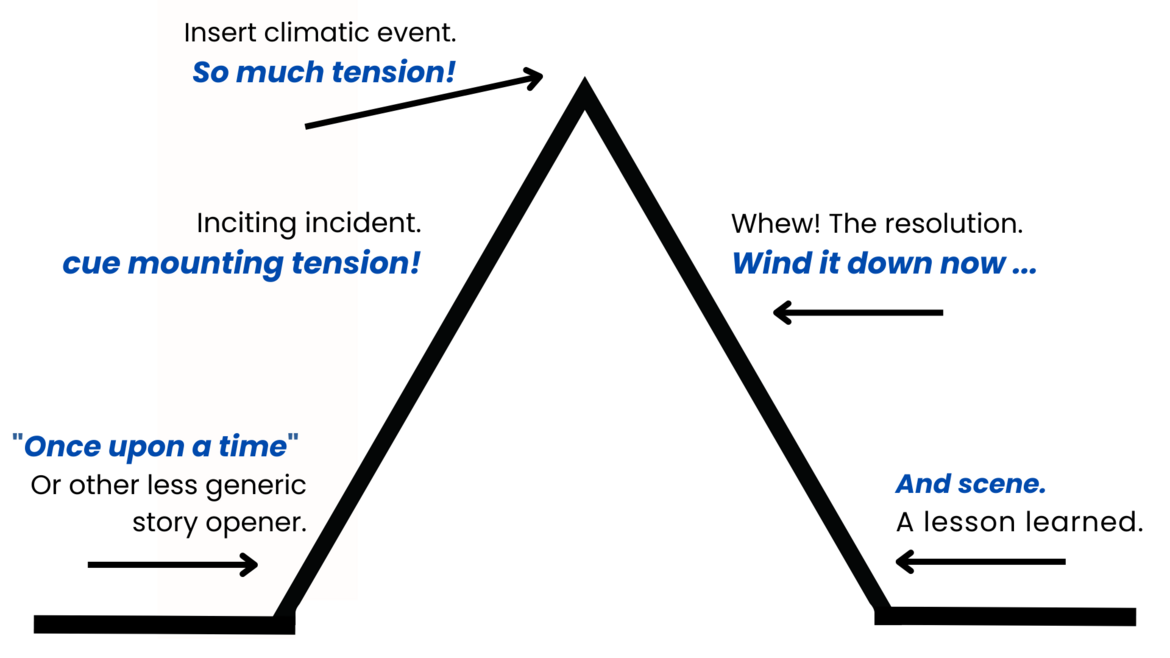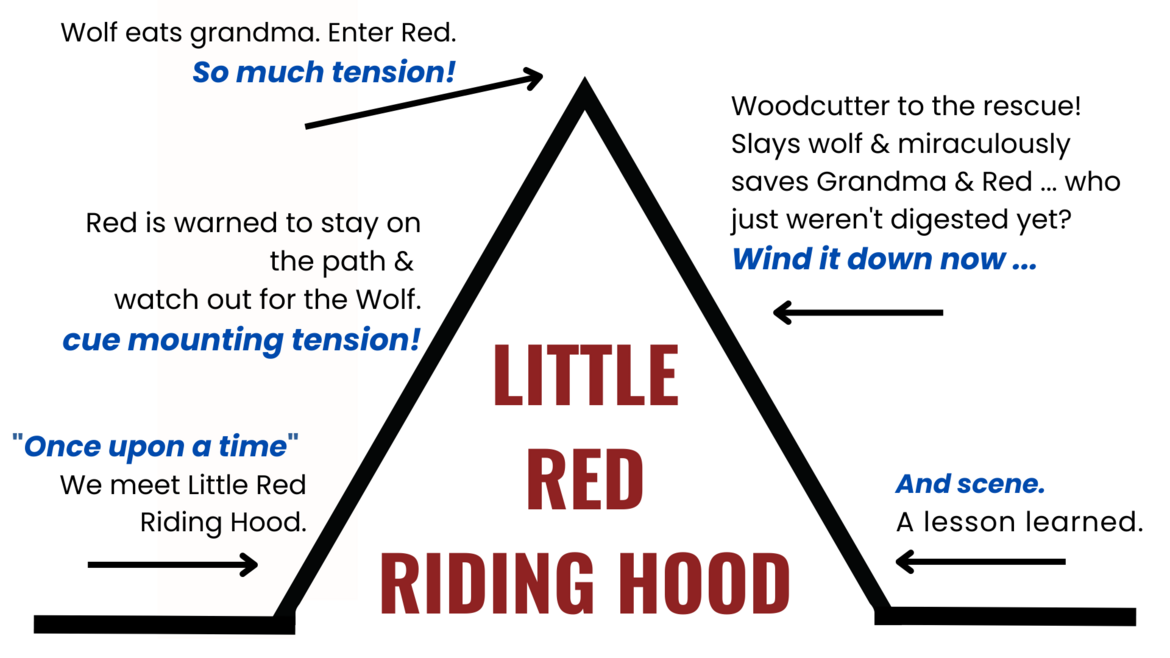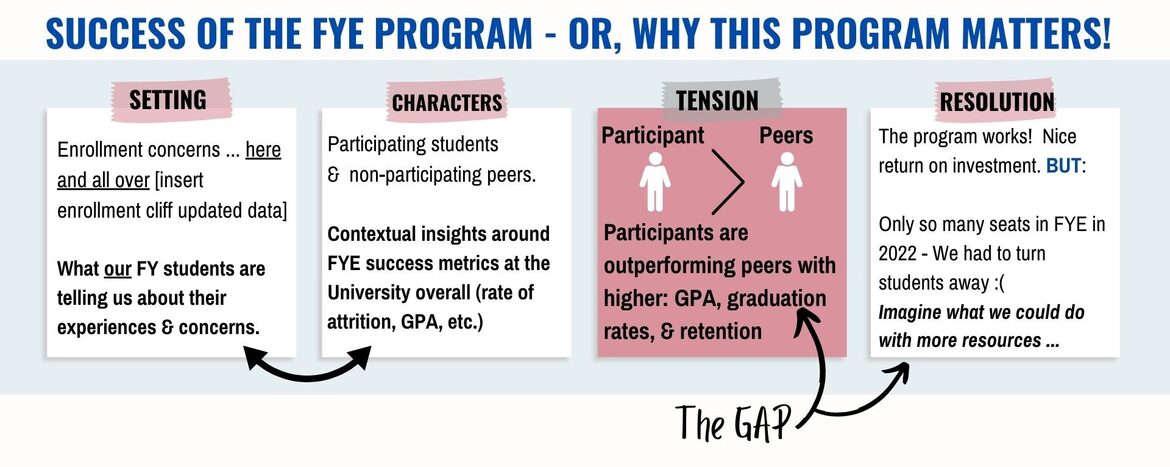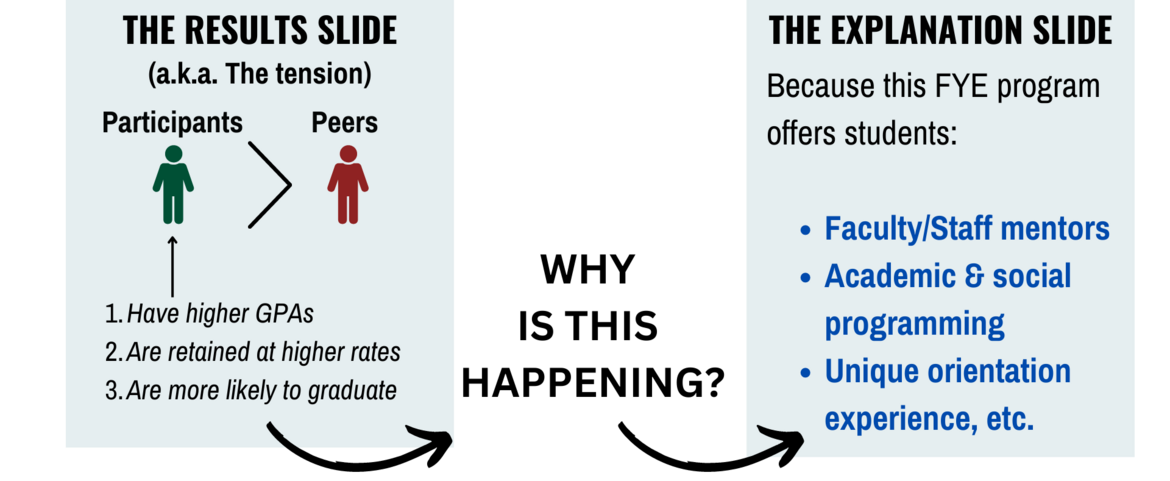At my institution, we talk a lot about telling the stories of our work. It’s central to everything we do in assessment. The problem is … this can be tough to do in our profession. Why? Well, when you think of storytelling, you might imagine something like this:

A neat, narrative arc.
Think, for example, of a story you might be familiar with: Little Red Riding Hood.

See, a neat, narrative arc.
In reality, the stories of Student Affairs almost never operate with such a clear plot line. Our stories are nuanced and full of complexity. So, how do we tell our stories effectively? How do we fit our data into a concise narrative that compels our stakeholders to act in important and necessary ways?
We storyboard!
Storyboarding is a technique used primarily in animation. The practice originated with Walt Disney himself back in the 1930’s. But this practice isn’t exclusive to the arts. The storyboarding concept as a tool has burst onto the scene in data analytics with Cole Nussbaumer Knaflic leading the charge with her Storytelling with Data books, podcast, and workshops (10/10 recommend).
So, how do you storyboard? You start by brainstorming - breaking down your story into four traditional storytelling elements: setting, characters, tension, and resolution.
We start with the Setting. What contextual details do your audience need to know? Don’t think of this as that slide - you know the one - that describes the size of your University, where you’re located, your research designation, famous alumni (… we could go on and on). Instead, think about your insider knowledge. You, as someone who is close to this story, likely have insights that your audience does not. Share those details that will make your story compelling. Set the scene.
Next up, your Characters! You want your audience to care about the characters in your story. In theory, this should be easy. Especially if your characters are your students. But as an insider to this particular story, who better to share some of those behind-the-scenes details about your characters? What are students telling you that shapes this particular story? What details do you need to share so your audience not only cares for your characters, but is rooting for their success?
Enter Tension: Tension is e-v-e-r-y-t-h-i-n-g. It also gets a bad rap. But if we don’t have tension – we don’t have a story. Tension is the problem you need to surmount. It’s the obstacle in your way. It’s the WHY this work matters. But, and this is key, to effectively tell your story, the tension should be presented from the vantage point of the audience. You want your audience to understand what’s at stake for them. Not you. Not your teams. What does the audience have to lose?
And the resolution! Sometimes your resolution is celebratory as in: Look what we did! We are awesome! Sometimes it’s action-oriented. You are asking your audience to act. You want to be specific here – make it explicit. This is your call to action. Knaflic calls this the “Big Idea” - the thing you want to make sure your audience doesn’t miss. Your resolution is your last opportunity to drive home the point.
As a strategy, storyboarding allows you to get clear on what story you need to tell. It allows you to brainstorm the elements to make sure you are telling the story in the way that you want to tell it. Once you have identified your elements, you are ready to outline your report, design your infographic, or curate your PowerPoint. No matter the vehicle you’ll use to tell your story, storyboarding allows you to sketch out what you need to include.
So, let’s try an example. Say you have a first-year experience (FYE) program on your campus. You, as an assessment leader, have been tasked with assessing the impact of this program. You get to work. Fortunately, this program is making a positive impact on student success AND they have the data to back it up. Students in the program are outperforming their peers in GPA, retention, and graduation rates.
Great! Now it’s time for you to put it all together and present this to your campus leadership.
Here’s how you might imagine this in a presentation:

The problem is - this isn’t much of a story. In fact, this isn’t a story at all.
This is a breakdown of facts. Good, important facts, absolutely. But facts alone do not make a story. What’s missing? Well, for one thing: TENSION. What’s your tension here?
Spoiler alert, it’s not the SUCCESS of your students.
This is where storyboarding really saves the day. Instead of starting with these traditional presentation elements, start with your story elements:

Do you see it? Your tension isn’t the success of your students – it’s the gap between those students and the comparison group of first-year peers who did not have access to this program. The tension resides not in the students who are reaping the many benefits of this program, but in those students who we are missing.
Now think about this – our job here is to explain why this tension (or gap) exists. And as the person who reviewed all this data, you already know the answer. This gap in performance exists because of the myriad of supports in place for the students who ARE participating in this program. It’s what makes this FYE program so impactful.
But in that first example of how you might deliver this message, those benefits get lost on Slide 2. Remember that Overview slide?

In the Overview you might have listed the benefits of participating in the FYE program. But by introducing them so early you run the risk of making these important benefits … well, easy to forget. A more memorable place to include them? Embed them in your tension.
Instead of walking your audience through a list of program benefits in a general overview slide or introduction section of a report. Introduce them as a way to explain why the gap (or tension) exists:


Draw the connections in your story. Make the bottom line explicit.
By storyboarding, we can intentionally place details where we want them. And by doing so, we can set the scene, introduce our characters, build to our tension, and then bring our resolution home … in celebration, or in a call to action. However, you choose – the ending of the story is yours to tell.
Blog written by Dr. Jordan Bullington-Miller, Research Associate at UNC Charlotte and blog team writer
References
Gabler, N. (2007). Walt Disney: The Triumph of the American Imagination. Penguin Random House.
Knaflic, C. N., (2015). Storytelling with Data: A Data Visualization Guide for Business Professions. Wiley.
